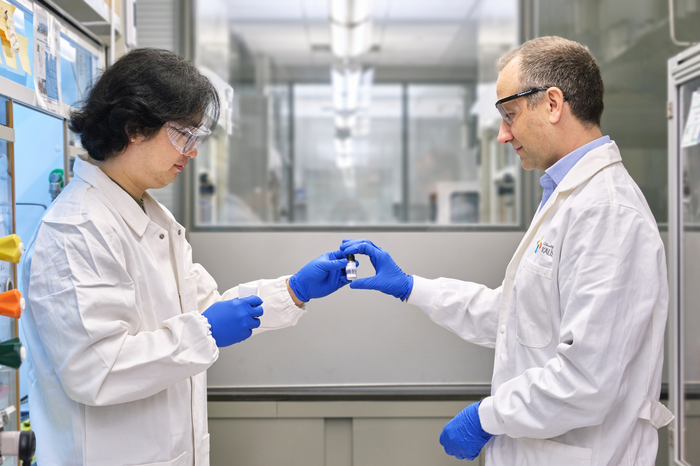After a new analysis of an old catalytic process, a significant ingredient in manufacturing sneaker soles and car tires could be made sustainably.
 Sang-Ho Chung (left) and Professor Javier Ruiz-Martinez (right) are exploring ways to use a decades-old catalyst to produce a valuable component in synthetic rubber more sustainably. Image Credit: 2023 King Abdullah University of Science and Technology; Eliza Mkhitaryan.
Sang-Ho Chung (left) and Professor Javier Ruiz-Martinez (right) are exploring ways to use a decades-old catalyst to produce a valuable component in synthetic rubber more sustainably. Image Credit: 2023 King Abdullah University of Science and Technology; Eliza Mkhitaryan.
Butadiene, a necessary component of synthetic rubber, is produced by the petrochemical industry from fossil reserves.
However, using a modernized version of an old catalyst, it can be made effectively in a one-step reaction from renewable ethanol.
Butadiene is currently produced as a byproduct of the petrochemical industry, which can lead to shortages in its supply. Also, these routes are clearly not sustainable.
Sang-Ho Chung, Study Co-Lead Author and Research Scientist, King Abdullah University of Science & Technology
Chung co-led the work with Ruiz-Martinez.
Such difficulties in butadiene production have triggered renewed interest in the Lebedev process initially developed in the 1930s, which converts ethanol to butadiene in a single catalytic reactor.
Sustainable butadiene could be made by using bioethanol in the Lebedev process or even ethanol made using cutting-edge CO -to-ethanol processes.
Sang-Ho Chung, Study Co-Lead Author and Research Scientist, King Abdullah University of Science & Technology
By adopting a unique method known as wet kneading, the Lebedev process has been driven by silica-magnesia catalysts. The method involves integrating solid catalyst precursors in the water while being subjected to continuous mixing.
“Wet kneading is quite uncommon in catalyst preparation, but it is often applied to prepare high-performance silicamagnesia catalysts for the Lebedev process,” states Ruiz-Martinez.
Enhanced wet-kneaded catalysts have primarily been discovered by trial and error. The reason why few catalysts surpass others is yet to be wholly understood, and “understanding how these materials form is the first step to preparing better catalysts,” stated Ruiz-Martinez.
Chung, Ruiz-Martinez, and their KAUST collaborators used solid-state nuclear magnetic resonance spectroscopy to study silica-magnesia catalyst formation while subjected to wet kneading conditions.
We found that two different catalyst particles are formed, based on the cross-deposition of silicon species onto magnesia and magnesium species onto silica.
Sang-Ho Chung, Study Co-Lead Author and Research Scientist, King Abdullah University of Science & Technology
The studies showed that magnesium silicates on the silica particles tend to produce ethylene as an unsought side product.
“With that understanding, we could synthesize just the catalyst particles that are active for butadiene production and avoid the particles that produce ethylene,” states Chung.
The team revealed that the best catalysts had also come from active sites nearby.
Ruiz Martinez states, “This has helped us to work on the next generation of catalysts for this process. We are making good progress and already have an even more selective version, which could be a key step for commercializing the process.”
Journal Reference
Chung, S-H., et al. (2023) Origin of active sites on silica–magnesia catalysts and control of reactive environment in the one-step ethanol-to-butadiene process. Nature Catalysis. doi.org/10.1038/s41929-023-00945-0.